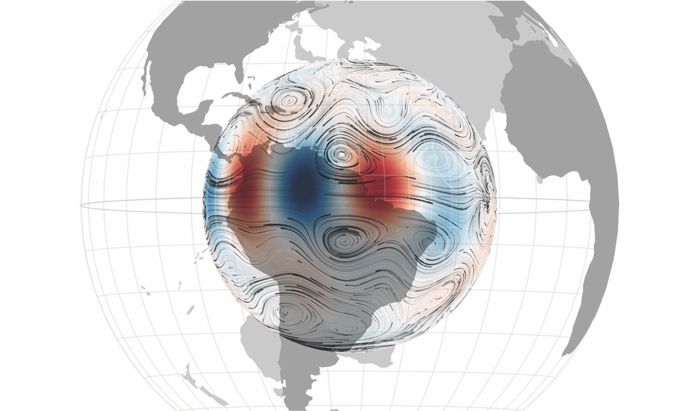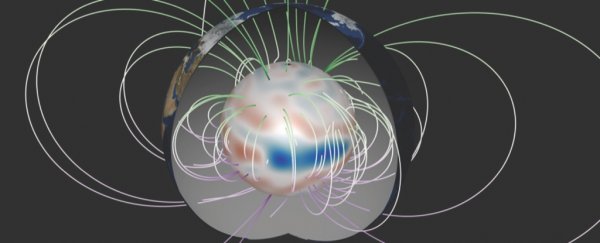Earth's interior is a far from quiet place. Deep below our surface activities, the planet rumbles with activity, from plate tectonics to convection currents that circulate through the hot magmatic fluids far underneath the crust.
Now scientists studying satellite data of Earth have identified something inside Earth we've never seen before: a new type of magnetic wave that sweeps around the surface of our planet's core, every seven years.
This discovery could offer insight into how Earth's magnetic field is generated, and provide clues of our planet's thermal history and evolution – that is, the gradual cooling of the planetary interior.
 Visualization of the waves at the core-mantle boundary. (Université Grenoble Alpes)
Visualization of the waves at the core-mantle boundary. (Université Grenoble Alpes)
"Geophysicists have long theorized over the existence of such waves, but they were thought to take place over much longer time scales than our research has shown," says geophysicist Nicolas Gillet of the Université Grenoble Alpes in France.
"Measurements of the magnetic field from instruments based on the surface of Earth suggested that there was some kind of wave action, but we needed the global coverage offered by measurements from space to reveal what is actually going on.
"We combined satellite measurements from Swarm, and also from the earlier German Champ mission and Danish Ørsted mission, with a computer model of the geodynamo to explain what the ground-based data had thrown up – and this led to our discovery."
Earth's magnetic field is the subject of much fascination for scientists. Research to date suggests that the invisible structure forms a protective 'bubble' around our planet, keeping harmful radiation out and the atmosphere in, thus allowing life to thrive.
But the magnetic field isn't static. It fluctuates in strength, size, and shape, has features we don't understand, and is gradually weakening over time.
The reason that activity inside our planet is important is because that's where the magnetic field comes from. It's generated by a dynamo – a rotating, convecting, and electrically conducting fluid that converts kinetic energy into magnetic energy, spinning a magnetic field out into space around the planet.
That fluid is (mostly) the molten iron inside Earth's outer core.

The European Space Agency's Swarm satellites are a trio of identical probes, launched in 2013 and hanging out in Earth orbit to study the activity inside Earth – with a specific eye on the magnetic and dynamic activity coming out of the core. It was in this data that Gillet and his team discovered the fascinating new waves.
They then studied data from other ground- and space-based observatories, collected between 1999 and 2021, and found a pattern.
These waves, known as magneto-Coriolis waves, are huge magnetic columns aligned along Earth's rotational axis, strongest at the equator.
They sweep around the boundary between the core and the mantle with an amplitude of around 3 kilometers (1.86 miles) per year, and move westward at a rate of up to 1,500 kilometers (932 miles) per year.
Their existence suggests that other magneto-Coriolis waves might exist with different oscillation periods, which we are unable to detect to date, due to a lack of data.
"Magnetic waves are likely to be triggered by disturbances deep within the Earth's fluid core, possibly related to buoyancy plumes," Gillet says.
"Our research suggests that other such waves are likely to exist, probably with longer periods – but their discovery relies on more research."
For now, because waves carry information about the medium through which they travel, new discovery could be used to probe the interior of our planet in new ways – including the core, which is difficult to study, as well as the core-mantle boundary.
The team's research has been published in PNAS.
